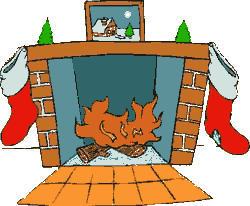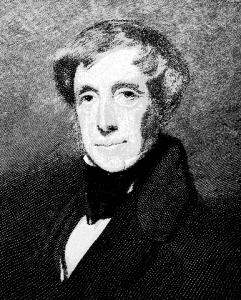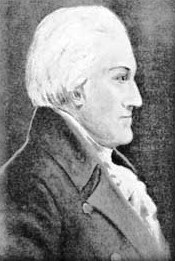 A Visit From St. Nicholas
A Visit From St. Nicholas
‘Twas the night before Christmas, when all through the house,
Not a creature was stirring, not even a mouse;
The stockings were hung by the chimney with care,
In hopes that ST. NICHOLAS soon would be there;
The children were nestled all snug in their beds, While visions of sugar-plums danced in their heads; And mamma in her ‘kerchief, and I in my cap, Had just settled down for a long winter’s nap,
When out on the lawn there arose such a clatter, I sprang from the bed to see what was the matter. Away to the window I flew like a flash, Tore open the shutters and threw up the sash.
The moon on the breast of the new-fallen snow Gave the lustre of mid-day to objects below, When, what to my wondering eyes should appear, But a miniature sleigh, and eight tiny reindeer,
With a little old driver, so lively and quick, I knew in a moment it must be St. Nick. More rapid than eagles his coursers they came, And he whistled, and shouted, and called them by name; “Now, DASHER! now, DANCER! now, PRANCER and VIXEN! On, COMET! on CUPID! on, DONDER and BLITZEN! To the top of the porch! to the top of the wall! Now dash away! dash away! dash away all!”
As dry leaves that before the wild hurricane fly, When they meet with an obstacle, mount to the sky, So up to the house-top the coursers they flew, With the sleigh full of toys, and St. Nicholas too. And then, in a twinkling, I heard on the roof The prancing and pawing of each little hoof. As I drew in my hand, and was turning around, Down the chimney St. Nicholas came with a bound. He was dressed all in fur, from his head to his foot, And his clothes were all tarnished with ashes and soot;
A bundle of toys he had flung on his back, And he looked like a peddler just opening his pack. His eyes — how they twinkled! his dimples how merry! His cheeks were like roses, his nose like a cherry! His droll little mouth was drawn up like a bow, And the beard of his chin was as white as the snow; The stump of a pipe he held tight in his teeth, And the smoke it encircled his head like a wreath; He had a broad face and a little round belly, That shook, when he laughed like a bowlful of jelly.
He was chubby and plump, a right jolly old elf, And I laughed when I saw him, in spite of myself; A wink of his eye and a twist of his head, Soon gave me to know I had nothing to dread; He spoke not a word, but went straight to his work, And filled all the stockings; then turned with a jerk, And laying his finger aside of his nose, And giving a nod, up the chimney he rose; He sprang to his sleigh, to his team gave a whistle, And away they all flew like the down of a thistle. But I heard him exclaim, ere he drove out of sight,
“HAPPY CHRISTMAS TO ALL, AND TO ALL A GOOD-NIGHT.”
About A Visit from St. Nicholas
On Christmas Eve night, while his wife and children sleep, a father awakens to noises outside his house. Looking out the window, he sees Santa Claus (Saint Nicholas) in an air-borne sleigh pulled by eight reindeer. After landing his sleigh on the roof, the saint enters the house through the chimney, carrying a sack of toys with him. The father watches Santa filling the children’s Christmas stockings hanging by the fire, and laughs to himself. They share a conspiratorial moment before Santa bounds up the chimney again. As he flies away, Santa wishes everyone a “Happy Christmas to all, and to all a good night.”
“A Visit from St. Nicholas”, more commonly known as “The Night Before Christmas” and “‘Twas the Night Before Christmas” from its first line, is a poem first published anonymously in 1823 and later attributed to Clement Clarke Moore, who claimed authorship in 1837. Some commentators now believe the poem was written by Henry Livingston Jr..
The poem has been called “arguably the best-known verses ever written by an American” and is largely responsible for some of the conceptions of Santa Claus from the mid-nineteenth century to today. It has had a massive impact on the history of Christmas gift-giving. Before the poem gained wide popularity, American ideas had varied considerably about Saint Nicholas and other Christmastide visitors. “A Visit from St. Nicholas” eventually was set to music and has been recorded by many artists.
History

(July 15, 1779 – July 10, 1863)
According to legend, “A Visit” was composed by Clement Clarke Moore on a snowy winter’s day during a shopping trip on a sleigh. His inspiration for the character of Saint Nicholas was a local Dutch handyman as well as the historical Saint Nicholas. Moore originated many of the features that are still associated with Santa Claus today while borrowing other aspects, such as the use of reindeer. The poem was first published anonymously in the Troy, New York Sentinel on 23 December 1823, having been sent there by a friend of Moore, and was reprinted frequently thereafter with no name attached. It was first attributed in print to Moore in 1837. Moore himself acknowledged authorship when he included it in his own book of poems in 1844. By then, the original publisher and at least seven others had already acknowledged his authorship. Moore had a reputation as an erudite professor and had not wished at first to be connected with the unscholarly verse. He included it in the anthology at the insistence of his children, for whom he had originally written the piece.
Moore’s conception of Saint Nicholas was borrowed from his friend Washington Irving (see below), but Moore portrayed his “jolly old elf” as arriving on Christmas Eve rather than Christmas Day. At the time that Moore wrote the poem, Christmas Day was overtaking New Year’s Day as the preferred genteel family holiday of the season, but some Protestants viewed Christmas as the result of “Catholic ignorance and deception” and still had reservations. By having Saint Nicholas arrive the night before, Moore “deftly shifted the focus away from Christmas Day with its still-problematic religious associations.” As a result, “New Yorkers embraced Moore’s child-centered version of Christmas as if they had been doing it all their lives.”
In An American Anthology, 1787–1900, editor Edmund Clarence Stedman reprinted the Moore version of the poem, including the German spelling of “Donder and Blitzen” that he adopted, rather than the earlier Dutch version from 1823 “Dunder and Blixem.” Both phrases translate as “Thunder and Lightning” in English, though the German word for thunder is “Donner” and the words in modern Dutch would be “Donder en Bliksem.”
Modern printings frequently incorporate alterations that reflect changing linguistic and cultural sensibilities. For example, breast in “The moon on the breast of the new-fallen snow” is frequently bowdlerized to crest; the archaic ere in “But I heard him exclaim ere he drove out of sight” is frequently replaced with as. Note that this change implies that Santa Claus made his exclamation during the moment that he disappeared from view, while the exclamation came before his disappearance in the original. “Happy Christmas to all, and to all a good-night” is frequently rendered with the traditional English locution “‘Merry Christmas'” and with “goodnight” as a single word.
Authorship controversy
Moore’s connection with the poem has been questioned by Professor Donald Foster, who used textual content analysis and external evidence to argue that Moore could not have been the author. Foster believes that Major Henry Livingston Jr., a New Yorker with Dutch and Scottish roots, should be considered the chief candidate for authorship, a view long espoused by the Livingston family. Livingston was distantly related to Moore’s wife. Foster’s claim, however, has been countered by document dealer and historian Seth Kaller, who once owned one of Moore’s original manuscripts of the poem. Kaller has offered a point-by-point rebuttal of both Foster’s linguistic analysis and external findings, buttressed by the work of autograph expert James Lowe and Dr. Joe Nickell, author of Pen, Ink and Evidence.
Evidence in favor of Moore
Moore is credited by his friend Charles Fenno Hoffman as author in the 25 December 1837 Pennsylvania Inquirer and Daily Courier. Further, the Rev. David Butler, who allegedly showed the poem to Sentinel editor Orville L. Holley, was a relative of Moore’s. A letter to Moore from the publisher states, “I understand from Mr. Holley that he received it from Mrs. Sackett, the wife of Mr. Daniel Sackett who was then a merchant in this city”. Moore preferred to be known for his more scholarly works, but allowed the poem to be included in his anthology in 1844 at the request of his children. By that time, the original publisher and at least seven others had already acknowledged his authorship. Livingston family lore gives credit to their forebear rather than Moore, but there is no proof that Livingston himself ever claimed authorship, nor has any record ever been found of any printing of the poem with Livingston’s name attached to it, despite more than 40 years of searches.

(October 13, 1748 – February 29, 1828
Evidence in favor of Livingston
Advocates for Livingston’s authorship argue that Moore “tried at first to disavow” the poem. They also posit that Moore falsely claimed to have translated a book. Document dealer and historian Seth Kaller has challenged both claims. Kaller examined the book in question, A Complete Treatise on Merinos and Other Sheep, as well as many letters signed by Moore, and found that the “signature” was not penned by Moore, and thus provides no evidence that Moore made any plagiaristic claim. Kaller’s findings were confirmed by autograph expert James Lowe, by Dr. Joe Nickell, the author of Pen, Ink & Evidence, and by others. According to Kaller, Moore’s name was likely written on the book by a New-York Historical Society cataloger to indicate that it had been a gift from Moore to the Society.
The following points have been advanced in order to credit the poem to Major Henry Livingston Jr.:
Livingston also wrote poetry primarily using an anapaestic metrical scheme, and it is claimed that some of the phraseology of A Visit is consistent with other poems by Livingston, and that Livingston’s poetry is more optimistic than Moore’s poetry published in his own name. But Stephen Nissenbaum argues in his Battle for Christmas that the poem could have been a social satire of the Victorianization of Christmas. Furthermore, Kaller claims that Foster cherry-picked only the poems that fit his thesis and that many of Moore’s unpublished works have a tenor, phraseology, and meter similar to A Visit. Moore had even written a letter titled “From Saint Nicholas” that may have predated 1823.
Foster also contends that Moore hated tobacco and would, therefore, never have depicted Saint Nicholas with a pipe. However, Kaller notes, the source of evidence for Moore’s supposed disapproval of tobacco is The Wine Drinker, another poem by him. In actuality, that verse contradicts such a claim. Moore’s The Wine Drinker criticizes self-righteous, hypocritical advocates of temperance who secretly indulge in the substances which they publicly oppose, and supports the social use of tobacco in moderation (as well as wine, and even opium, which was more acceptable in his day than it is now).
Foster also asserts that Livingston’s mother was Dutch, which accounts for the references to the Dutch Sinteklaes tradition and the use of the Dutch names “Dunder and Blixem”. Against this claim, it is suggested by Kaller that Moore — a friend of writer Washington Irving and member of the same literary society — may have acquired some of his knowledge of New York Dutch traditions from Irving. Irving had written A History of New York in 1809 under the name of “Dietrich Knickerbocker.” It includes several references to legends of Saint Nicholas, including the following that bears a close relationship to the poem:
And the sage Oloffe dreamed a dream,—and lo, the good St. Nicholas came riding over the tops of the trees, in that self-same wagon wherein he brings his yearly presents to children, and he descended hard by where the heroes of Communipaw had made their late repast. And he lit his pipe by the fire, and sat himself down and smoked; and as he smoked, the smoke from his pipe ascended into the air and spread like a cloud overhead. And Oloffe bethought him, and he hastened and climbed up to the top of one of the tallest trees, and saw that the smoke spread over a great extent of country; and as he considered it more attentively, he fancied that the great volume of smoke assumed a variety of marvelous forms, where in dim obscurity he saw shadowed out palaces and domes and lofty spires, all of which lasted but a moment, and then faded away, until the whole rolled off, and nothing but the green woods were left. And when St. Nicholas had smoked his pipe, he twisted it in his hatband, and laying his finger beside his nose, gave the astonished Van Kortlandt a very significant look; then, mounting his wagon, he returned over the tree-tops and disappeared. — Washington Irving, A History of New York
MacDonald P. Jackson, Emeritus Professor of English at the University of Auckland, New Zealand and a Fellow of the Royal Society of New Zealand, has spent his entire academic career analyzing authorship attribution. He has written a book titled Who Wrote “the Night Before Christmas”?: Analyzing the Clement Clarke Moore Vs. Henry Livingston Question, published in 2016, in which he evaluates the opposing arguments and, for the first time, uses the author-attribution techniques of modern computational stylistics to examine the long-standing controversy. Jackson employs a range of tests and introduces a new one, statistical analysis of phonemes; he concludes that Livingston is the true author of the classic work.
About A Visit from St. Nicholas Source: wikipedia
